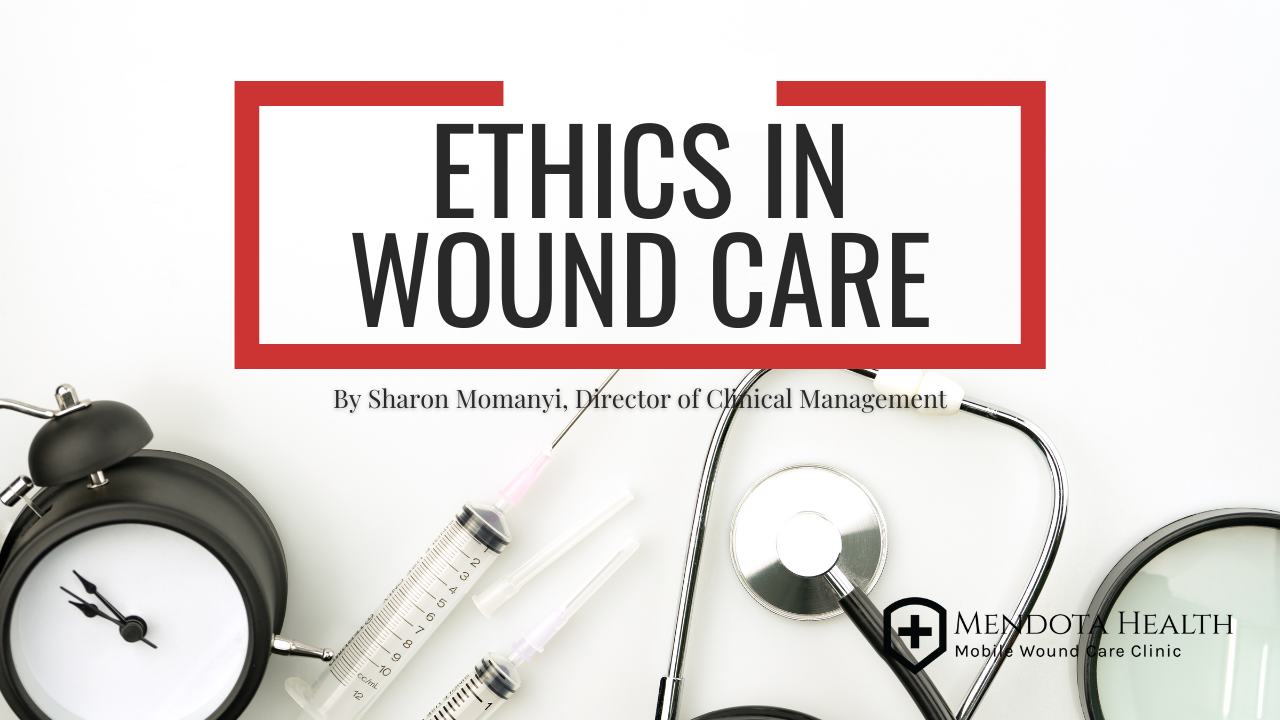
13 Feb Ethics in Wound Care
Introduction
Treating hard-to-heal wounds is a complex process that involves shared decision-making from the patient, caregivers, and treatment team. In treating complex wounds that have stalled and are labeled hard to heal, the medical team must consider ethical principles when making patient care decisions.
Medical ethics are the moral principles that should be a guiding factor when providing medical care to the patient. Finding solutions to complex problems requires considering the principles of beneficence, nonmaleficence, autonomy, and justice. The clinician can provide the best patient care and outcomes through this lens. Applying the principles of medical ethics, the practitioner and healthcare system must respect the rights of individuals, build trust, and seek information to implement effective treatment plans. Finally, the foundation of all treatments must incorporate honesty, integrity, respect, fairness, and good faith (American College of Healthcare Executives, n.d.).

Defining Beneficence, Nonmaleficence, Autonomy, and Justice in wound care
Considering beneficence, the provider must treat the patient and avoid harm. Following evidence-based medicine, the provider can utilize research and synthesize a treatment plan that will yield the best results for the patient while considering other factors, such as the clinician’s experience and the patient’s preference. Furthermore, the provider is responsible for ensuring that each patient treated has a voice in the plan and can discuss their issues without discrimination.
Nonmaleficence in wound care is essential in difficult situations and end-of-life care. The clinician has the obligation to do no harm to the patient. Assessment and formation of a treatment plan made with patients, caregivers, and providers are necessary to address the treatment issue in hard-to-heal wounds and, ultimately, the treatment goals.
Autonomy is the right of each patient over their own body. This principle includes informing the patient openly and understanding the treatment risks and benefits. The provider must tell the truth about a medical condition and be honest regarding the expected treatment plan and outcomes.
Justice is the distribution of health care resources fairly and equitably. It is the healthcare system’s responsibility to create a system that will provide comprehensive care to those who are underserved and marginalized in an equitable format. Failure to do this would be an ethical violation as identified by the World Health Organization (2017) universal right of attainable health, which includes education, prevention, control of preventable disease, treatment, and food security (World Health Organization, 2017).
Application to Practice
Knowing the basics of medical ethics, the wound care provider is responsible for acting with personal integrity and having flexibility in the treatment plan. This continues with the responsibility to assess how healable the wound is and the treatment options that will bring the highest success for the patient with the least risk of harm. Special consideration for end-of-life care: The provider has to weigh the benefits versus harm if no treatment is done or when treatment should be stopped. This can lead to internal forces for the provider and external forces of distributive justice. The clinician must examine the financial benefit of medically unnecessary service and the conflict of interest between organizations must be evaluated in these circumstances. Understanding clinically how a wound is likely to heal will help guide the clinician in managing resources to be used efficiently and safely for the patient.
Patients have the right to have autonomy over their body. Respecting the patient’s autonomy in a hard-to-heal wound, the provider has to address the concerns of the patients and caregivers with the necessary interventions to be explained thoroughly. An effective treatment plan for wound care has to follow respect for the patient and caregivers’ values and wishes. Forming an interprofessional team with communication is necessary for the success of such a plan. In recognition of the patient’s autonomy, the provider has to respect the patient’s values and adjust interventions and treatment plans that would be successful within the patient’s goals (Tahmasebi, 2022).
Conclusion
Medical ethics in wound care can be complex, especially when considering two or more ethical principles with conflicting views. Examining all possible treatment options with patient-centered care that provides safe, effective, efficient, and equitable resources are some guiding points when formulating an effective treatment plan. Developing a treatment plan considering all possible factors and including the patient, caregivers, and interdisciplinary team will address the conflicting ethical principles that will address the divergent goals while setting realistic expectations for healing by the patient, caregivers, and treatment team (Song, 2022).
References
- American College of Healthcare Executives. (n.d.). ACHE code of ethics.
https://www.ache.org/about-ache/our-story/our-commitments/ethics/ache-code-ofe-ethics
- Song E, Costa I, (2022). “Medical Ethics In Wound Care”. In Milne C, Robinson S, (Eds.) , WoundReference. Available from: https://woundreference.com/app/topic?id=medical-ethics-in-wound-care. Retrieved on 2/12/24
- Tahmasebi M. (2022). Ethics and palliative care: a case of patient’s autonomy. Journal of medical ethics and history of medicine, 15, 16. https://doi.org/10.18502/jmehm.v15i16.11574.
- World Health Organization (2017). Human rights and health. Human rights (who.int)

